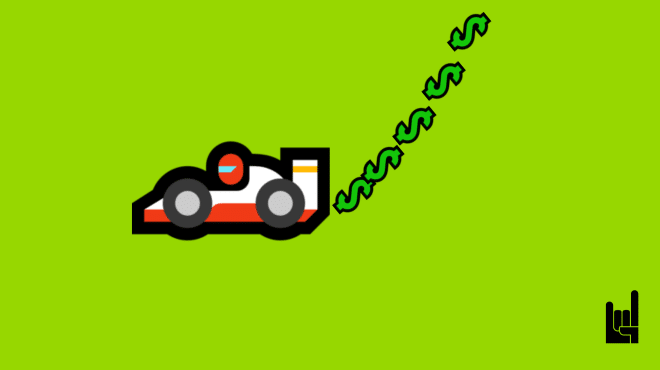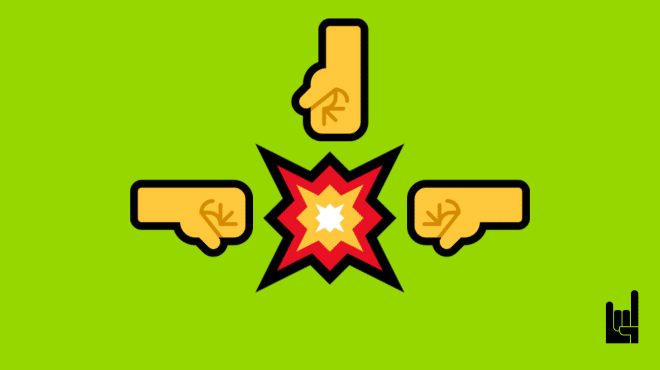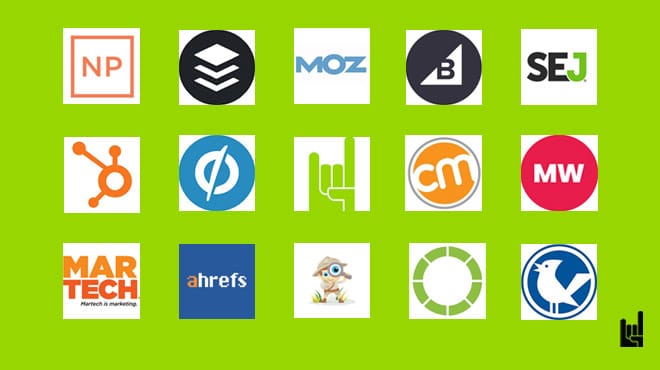Every business needs.
But at what cost?
This is the answer that you sooner or later will have to answer.
And only the way to answer that is through customer acquisition cost.
What Is Customer Acquisition Cost (CAC)?
Customer Acquisition Cost (CAC) is a metric used to evaluate the cost associated with acquiring a new customer.
CAC represents how much a company spends on marketing, sales, and other related activities to attract and convert a potential customer into an actual paying customer.
It’s a crucial growth metric for businesses because it helps them assess the efficiency and effectiveness of their marketing and sales efforts. Which is the opposite of a vanity metric.
How to Calculate CAC (CAC Formula)
To calculate CAC, you can use this simple formula: Customer Acquisition Cost (CAC) = (Total cost incurred on marketing & advertising / Total number of customers converted)
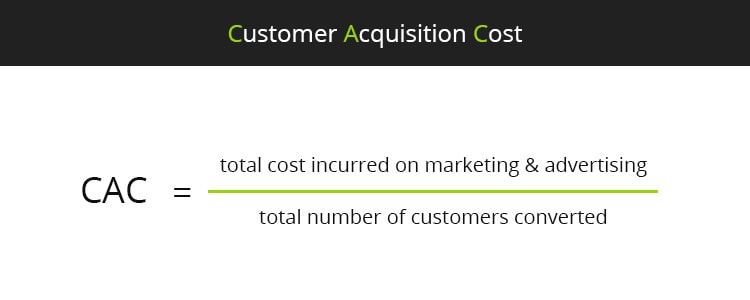
💡 Example: if you spend $100 on the marketing and advertising campaigns, and around 20 people buy the product by viewing that advertisement, your CAC would be $5.
Accordingly, CAC = $100 / 20 = $5
The Importance of CAC
CAC is such an important metric because it’s one of the best ways to assess many aspects of a business such as its efficiency, sustainability, and profitability.
- Financial health. CAC provides insights into the financial sustainability of a business. It helps you determine whether the cost of acquiring a customer is sustainable in relation to the revenue generated from that customer over their lifetime.
- Profitability. Understanding CAC is essential for achieving profitability. The CAC can also be compared to the Customer Lifetime Value (CLV), and draw conclusions for the cost-effectiveness of acquiring new customers. But more on CLV later.
- Resource allocation. CAC helps businesses allocate their marketing and sales resources more effectively. By identifying the most cost-efficient customer acquisition channels, companies can optimize their strategies and budgets.
- Investor confidence. For startups and businesses seeking investments, CAC, and its relationship to CLV, is a crucial metric. It’s also a key metric for most SaaS valuations.
- Cost reduction. Understanding CAC can highlight opportunities for cost reduction in customer acquisition. By calculating the CAC in your business, can look for ways to optimize their processes and reduce their acquisition cost.
Kinds of businesses that need to measure CAC the most
CAC can be a vital metric for most kinds of businesses. However, like churn rate, it matters most for businesses in competitive markets with recurring revenue models, such as:
Subscription services. From streaming and food delivery to fitness and fashion, CAC is imperative for businesses with these subscription services they rely on a recurring revenue model.
SaaS (Software as a Service). The SaaS industry is a highly competitive landscape and most SaaS businesses work with a subscription model.
Mobile apps. Mobile apps’s business model typically relies on in-app purchases, subscriptions, or advertising.
B2B (Business-to-Business) services. B2B companies, such as agencies or software providers, often need to measure CAC as they spend a lot on advertising and sales and there is an ongoing relationship with B2B clients, in contrast to B2C customers.
What Is a Good CAC?
By now, you’ve probably realized that the lower the CAC the better. A lower CAC means that you’re getting customers more efficiently. At the same time, you need to ensure the value you get from these customers is worth the cost.
That said, CAC differs from industry to industry. For example, the average CAC in the retail industry is $10, while in real estate is 20 times that.
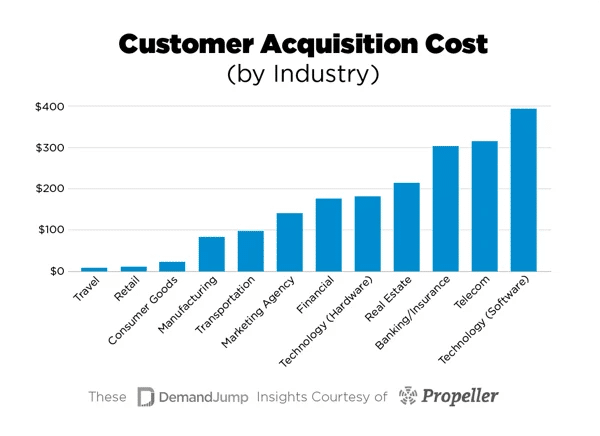
Accordingly, to find what is a good CAC for your business, you will need to compare it with the industry average.
So, for example, if you are in the Banking/ Insurance industry and you have a CAC of $400, then that’s a good sign that you need to start optimizing your customer acquisition stage in your funnel.
But CAC alone is not always enough. While CAC is crucial for understanding the direct cost of customer acquisition, you will also need a deeper and more strategic perspective. To gain that insight you will have to measure CAC in relation to what is called CLV—Customer Lifetime Value.
CLV to CAC Ratio
The CLV to CAC ratio is a metric that compares the value of a customer to the cost of acquiring them.
Finding the CLV:CAC ratio means realizing not only the efficiency of your acquisition efforts but also your long-term sustainability and profitability.
But first, let’s have a more in-depth look at CLV.
What is CLV?
Customer Lifetime Value, or CLV, measures the total revenue a company expects from a single customer over a span of time. This metric provides businesses with valuable insights into the overall worth of their customer base.
CLV goes beyond the immediate transactional value, focusing on the extended contribution each customer makes to the company’s bottom line.
Measuring CLV
The formula of CLV is as follows: CLV = Customer Value x Average Customer Lifespan
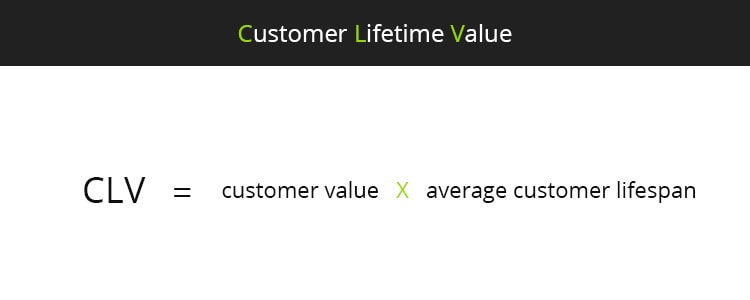
💡 Example: Suppose the average purchase value is $50. The purchase frequency is 2 transactions per month. And the customer lifespan is estimated at 2 years.
Accordingly, CLV = $50 x 2 x 2 = $200
In this example, the estimated CLV for each customer is $200 over the course of their relationship with the business.
Measuring CLV to CAC Ratio
Now that you know more about CLV and CAC, the formula to calculate the ratio is pretty straightforward. And it looks like this: CLV ratio = Customer Lifetime Value / Customer Acquisition Cost
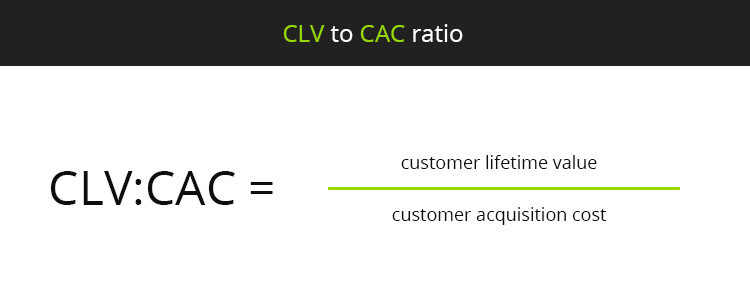
💡 Example: if the total customer lifetime value is $1000, and the customer acquisition cost is $200, then
CLV to CAC Ratio = $1000/$200 = 5:1
What is a good CLV:CAC ratio?
As with CAC, CLV:CAC ratio can vary depending on factors such as industry and business model.
Nonetheless, as a general rule of thumb, a CLV:CAC ratio greater than 3:1 is what you should be aiming for.
A ratio above 1:1 is an indication that the business is not only covering acquisition costs but also making a substantial profit over the customer’s lifetime.
A ratio around 1:1 is a break-even scenario where the business is recovering the cost of customer acquisition but may have limited room for profitability.
A ratio below 1:1 shows that the cost of acquiring customers exceeds the value they bring over their lifetime that the business is facing challenges.
How to Improve CAC and CLV to CAC Ratio?
To improve CLV to CAC ratio, you will either need to increase your CLV or decrease your CAC. Or even better—do both.
Some of the best tactics for decreasing your CAC and increasing your CLV are:
- Personalization. Personalize your products, services, and marketing messages to foster stronger connections and loyalty. B2B marketing personalization is overlooked more than it should.
- Improved customer service. Happy customers are more likely to make repeat purchases and become long-term clients.
- Educate your customers. Informed customers on the full range of your products or services are more likely to explore and buy different offerings over time.
- Upselling and cross-selling. Coming from the previous point, you need to identify opportunities to upsell or cross-sell additional products or services.
- Subscription models. Consider introducing subscription models to encourage recurring revenue, wherever they can be applied. Subscriptions create a predictable income stream and foster long-term commitments.
- Loyalty programs & rewards. Rewarding loyalty encourages customers to continue choosing your brand. What’s more, you can provide exclusive discounts, promotions, or early access to existing customers.
- Customer feedback. Act on customer feedback to improve your products or services. Customers appreciate when their opinions are valued, fostering a positive relationship.
- Community building. Create a community around your brand where customers can connect. A sense of belonging encourages long-term relationships and loyalty.
- Quality content. Develop and share high-quality content that adds value to your customers. A solid content marketing strategy can also become the main component of your inbound marketing.
- Re-engagement campaigns. Implement campaigns to re-engage inactive or dormant customers. Encourage them to return with special offers or personalized messages.
Conclusion
For most kinds of businesses, there aren’t many metrics that can predict marketing effectiveness, revenue, and profitability as successfully as CAC.
The CLV to CAC ratio, in particular, can be the north start metric that makes the most sense for your kind of business, at the stage you happen to be right now.
Are you looking to improve your CAC, CLV, or any other kind of business metric?
Contact us and let’s find out if we can work together.

I write for GrowthRocks, one of the top growth hacking agencies. For some mysterious reason, I write on the internet yet I’m not a vegan, I don’t do yoga and I don’t drink smoothies.
